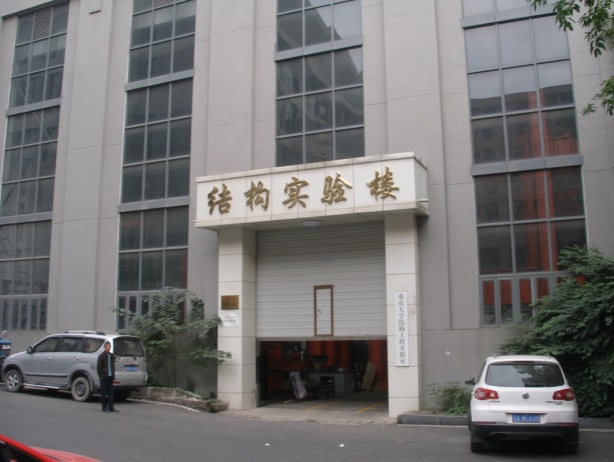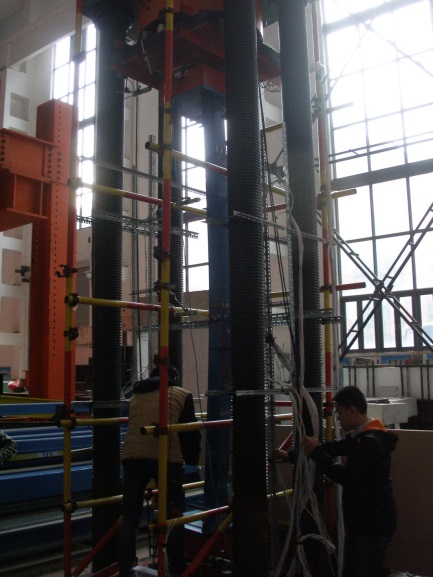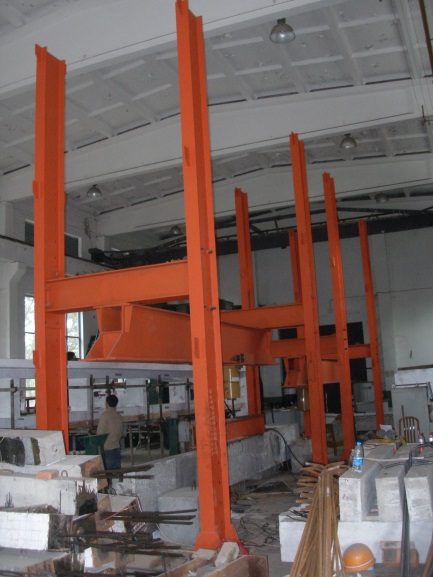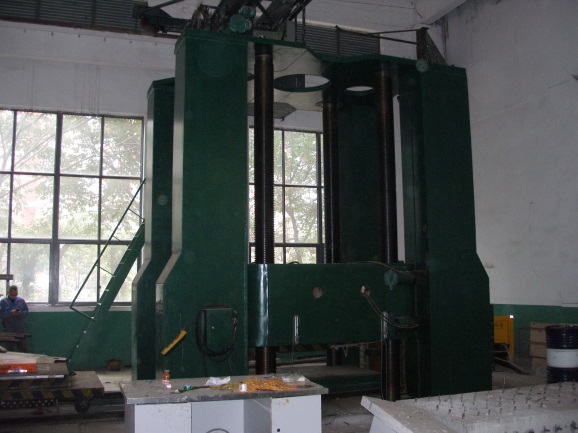1. Overview
The structures laboratory is in top-ranking level of the whole nation, including large-scale and regular structural testing facilities with the total area of 2048 m2 and the total number of more than 750 devices. This laboratory is equipped with Flextest GT electro-hydraulic servo controlled loading system, MTS large-tonnage electro-hydraulic servo fatigue testing system, 20 MN Computer controlled servo compression-shear testing machine, 10MN electro-hydraulic servo long-column testing machine, 5000kN long-column testing machine, 1000kN/600kN/100kN material testing machine, portable static and dynamic data acquisition system, vibration testing, dynamic signal analysis and experimental modal system.

Besides the static, dynamic, fatigue and seismic-resistant tests for structural members, this laboratory can be used to investigate catastrophic behaviors of complex structure, develop the design theory of large and complex structural systems, and apply the new material and new technologies in the heavy structures.
The structures laboratory is focused on the coordinated development of scientific research, talent training and scientific and technical service since its foundation. The graduates can assess this lab and have a specialized course “comprehensive experiments of civil structures”. Also, this lab is used to facilitate the graduate-independent experimental programs and innovative practice programs.
This lab is used for both research and practical applications and has conducted a large amount of structural tests, which is of great significance for the key construction projects in southwest China.
2. Large-scale structures laboratory
In 1980s, the former Chongqing Architecture Engineering Institute imported the MTS large-tonnage electro-hydraulic servo testing system and built the structures laboratory, which later became the key laboratory of former Ministry of Construction and Sichuan Province.
This lab is almost 42m long, and composed of testing area, engine room and offices.
Experimental area is about 21m deep, equipped with a 25 ton overhead crane, crane track at the elevation of 15m with two hooks of lifting weights of 25 ton and 5 ton. At the end of the experimental area, there is a piece of reaction wall with the design load of 10 ton/m, the height of 13.2m and the width of 12.6m. This laboratory is equipped with a variety of reaction frames, of which the maximum span is 9m and the height of 13 m. This laboratory ground features with multi-channel slots (6 at the left side and 8 at the right side) to anchor the reaction frames and the slot spacing is 1.5 m and the resistant force is 50 ton/m, of which the two near the entrance are 75 ton/m.
2.1. MTS electro-hydraulic servo testing system
MTS electro-hydraulic servo testing system was built up in the 1980s using the World Bank loans, which was partly upgraded. The system was manufactured by the American company MTS with the model type Flextest GT. The main technical parameters are six control channels; 16-bit AD / DA converter; 6kHz data acquisition speed; 1000kN electro-hydraulic servo-type actuator standard stroke ± 250mm, maximum output 1000kN, displacement accuracy 1/100, force accuracy 1/100, force frequency of 20Hz, mainly used for a variety of structural testings such as pseudo-dynamic, low cyclic loading, low cyclic fatigue and so on.
2.2. MTS large tonnage electro-hydraulic servo fatigue testing
MTS large tonnage electro-hydraulic servo fatigue testing system is equipped with a multi-channel closed-loop coordinated loading system, which can automatically produce continuous and constant load, sustain load, data collection, storage, drawing curves, automatically print test report. This lab can be used to investigate the fatigue behaviors (≤15 Hz) of large and complex structures (high-rise buildings and long-span bridges) and this lab is also a multi-function and compostable experimental platform that can integrate various types of structural tests except shaking table tests. The advantages of this lab can greatly improve the structural reliability and significantly enhance the structural testing capabilities.
The system adopts the high-precision pressure sensors for force measurement, imported servo valve components and its overall performance is stable and reliable. The key technical indicators are that the maximum horizontal dynamic shear force value ± 1000 kN, effective stroke ±250 mm, operating frequency: 0.0~15 Hz, Indication accuracy >±1%; vertical maximum pressure: ≥5000kN, axial displacement 300mm, indication accuracy >±1%.
The experimental system can be used to conduct the following tests: the low cyclic fatigue tests of large structural members; fatigue testing of composite structures in large structures; fatigue test of prestressed beam; fatigue test of concrete\steel joints; pseudo-dynamic\quasi-static loading and other structural loading scenarios.
2.3. 10 MN long travel stroke electro-hydraulic servo testing machine
2.3.1. Functions
10 MN long travel stroke electro-hydraulic servo testing machine is intended to test flexure loading of beams, axial loading capacity of columns and splitting tensile strength. It is suitable to test various metallic & non-metallic materials for tension, compression, bending and shearing strength. It is capable of automatic piston zero positioned, automatic calibration and continuous measurement in real time. It allows precise control of load, strain and position rates when used with test software. All kinds of control strategies can be freely switched in the test.
2.3.2. Main technical parameters
Max. capacity: ±10MN
Measuring range: 1% to 100% full scale (F•S)
Load accuracy: ±1%
Displacement resolution: 0.01 mm
Deformation accuracy: 0.5% full scale (F•S)
Testing speed range: 1% to 100% full scale per minute
Loading duration: >24 hours
Control System allowing precise equal-rate control of load and displacement
Multiple control strategies: computer software control and data processing; hand held control and computer display; hand held control and EDC display; only EDC-controlled without computer
Working pressure for hydraulic loading system: 31.5MPa

2.4. Various portable static and dynamic data acquisition systems
The high-speed data acquisition systems are employed for the dynamic data sampling and data processing during the dynamic and static loading process. Main performance specifications are 200 acquisition points in main engine and balance box and 500 points/sec for the sampling rate.
3. Conventional laboratory
The conventional laboratory is a one-story bent structure, with 54 m long and 15m wide. In the lab, there is crane with capacity of 5 ton and the lifting weights are 5 tons and 3 tons for the hook and small hooks, respectively. The height of crane rail is 6.5 m. Eight geosynclines are equipped in the lab to anchor the reaction frame.


3.1. 20 MN microcomputer-controlled electro-hydraulic Servo load-shear testing machine
3.1.1. Functions
This testing machine adopts a four column load frame, hydraulic hitch lock system and electro-hydraulic servo control system with multichannel closed-loop coordinated loading system. It can automatically load by a continues and steady state, auto-save, auto-record, draw and print test curves automatically. It is equipped with test control software specialized for the mechanics performance testing of laminated and pot rubber bearing spherical bearing. This system can conduct many tests including: compressive and shear elastic modulus of rubber bearing of bridges, bond behavior, ageing for shear resistance, friction coefficient between PTFE plate and steel plate, rotation, ultimate compressive strength, allowable rotation, and some other special test in civil engineering structures.
3.1.2. Main technical parameters
Max. vertical capacity: 20MN
Electro-hydraulic servo load automatically
Measuring range: continuous gears and equivalent six gears, accuracy of deformation: ±1%
Testing space: 0mm~2500 mm (adjustable)
Compression platens: steel plate with hardness of 58-62 HRC
Dimension of compression plate: 1500 mm×1800 mm
Max. distance between compression surfaces: 1200 mm
Max. stroke of working piston: 200 mm
Max. horizontal capacity: 4000 kN
Max. force generated by rotation: 2000 kN
